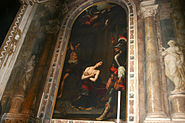- For things named after Saint Pancras see the disambiguation page: St Pancras. See also Saint Pancras of Taormina and San Pancrazio (disambiguation).
| Saint Pancras | |
|---|---|
| Saint Pancras, by Guercino, ca. 1616. | |
| Born | ~289 AD, Synnada, Phrygia |
| Died | ~304 AD, Via Aurelia, Rome |
| Venerated in | Roman Catholic Church; Eastern Orthodox Church |
| Major shrine | San Pancrazio, Rome |
| Feast | May 12 |
| Attributes | depicted as a young man or soldier |
| Patronage | children; invoked against cramp, false witness, headache, and perjury |
Saint Pancras was a Roman citizen who converted to Christianity, and was beheaded for his faith at the age of just 14 around the year 304. His name is Greek and literally means "the one that holds everything".
From 1595 (25 years after Pope Pius V promulgated the Tridentine Missal) until 1969, Saint Pancras was venerated together with Saints Nereus and Achilleus and Saint Domitilla in a shared feastday and Mass formula on 12 May.
Saint Pancras is now venerated separately, still on 12 May. He is, traditionally, the second of the Ice Saints.
Legend[]
Since he was said to have been martyred at the age of fourteen during the persecution under Diocletian, Pancras would have been born around 289, at a place designated as near Synnada, a city of Phrygia Salutaris, to parents of Roman citizenship. His mother Cyriada died during childbirth, while his father Cleonius died when Pancras was eight years old. Pancras was entrusted to his uncle Dionysius’ care. They both moved to Rome to live in a villa on the Caelian Hill. They converted to Christianity, and Pancras became a zealous adherent of the religion.
During the persecution of Christians by Diocletian, around 303 AD, he was brought before the authorities and asked to perform a sacrifice to the Roman gods. Diocletian, impressed with the boy's determination to resist, promised him wealth and power, but Pancras refused, and finally the emperor ordered him to be decapitated on the Via Aurelia, on May 12, 303 AD; this traditional year of his martyrdom cannot be squared with the saint's defiance of Diocletian in Rome, which the emperor had not visited since 286, nor with the mention of Cornelius (251-253) as bishop of Rome at the time of the martyrdom, as the most recent monograph on Pancras's texts and cult has pointed out.[1]
A Roman matron named Ottavilla recovered Pancras's body, covered it with balsam, wrapped it in precious linens, and buried it in a newly built sepulcher dug in the Catacombs of Rome. Pancras’ head was placed in the reliquary that still exists today in the Basilica of San Pancrazio.[2]
Veneration[]
Devotion to Pancras definitely existed from the fifth century onwards, for the basilica of San Pancrazio was built by Pope Symmachus (498-514), on the place where the body of the young martyr had been buried; his earliest passio seems to have been written during this time.[2] Gregory the Great gave impetus to the cult of Pancras, sending Augustine to England carrying relics of that saint and including his legend in Liber in gloria martyrum. In medieval iconography, Pancras was depicted as a young soldier, due to his association with the paired soldier saints Nereus and Achilleus.[3] By the mid-nineteenth century, pious embroidery set Pancras's martyrdom in the arena among wild beasts, where the panther refrains from attacking and killing him until the martyr gives the beast permission.
The basilica of San Pancrazio was built by Pope Symmachus (498-514), on the place where the body of the young martyr had been buried. In the 17th century, it was given to the Carmelites.
In Spain St. Pancras is referred to as San Pancracio. He is popularly venerated as the patron saint of jobs and health. He is offered parsley.[4] His image in statue form can be found in many bars, restaurants and other businesses.
Some of his relics found their way to England, which is why many of the nation's churches are dedicated to him; St Pancras Old Church is believed to be one of the oldest sites of Christian worship in England.
Pancras is normally invoked against cramp, false witness, headache, and perjury. He is a patron saint of children.
Cultural references[]
He is also featured in Nicholas Wiseman's novel Fabiola, as the gentle antagonist of the villain Corvinus. There are also changes to his martyrdom in the book, where he is thrown to the circus beasts instead of being beheaded.
References[]
- ↑ Hubertus Drobner, Der heilige Pankratius: Leben, Legende und Verehrung 2nd rev. ed. 2005. (Paderborn:Bonifatius Verlag) is the most complete modern monograph on the texts and the spread of the cultus.
- ↑ 2.0 2.1 San Pancrazio Martire
- ↑ Eleanor P. Spencer and Wolfgang Stechow,, "Sts. Nereus and Achilleus in the Fifteenth Century" The Art Bulletin 48.2 (June 1966:207-209).
- ↑ "But anywhere they sell bread, specially in the area around Sineu, there's always a figure of Saint Pancras. He should never be without his sprig of parsley," reports Na Fiola, in Tomás Graves, Bread & oil: Majorcan culture's last stand, 2002, p. 72.
External links[]
ca:Sant Pancraç cs:Svatý Pankrác hr:Sveti Pankracije la:Sanctus Pancratius Romae nap:San Francazio pt:São Pancrácio ro:Pancraţiu ru:Панкратий Римский sr:Панкратије Римски sv:Pankratius


